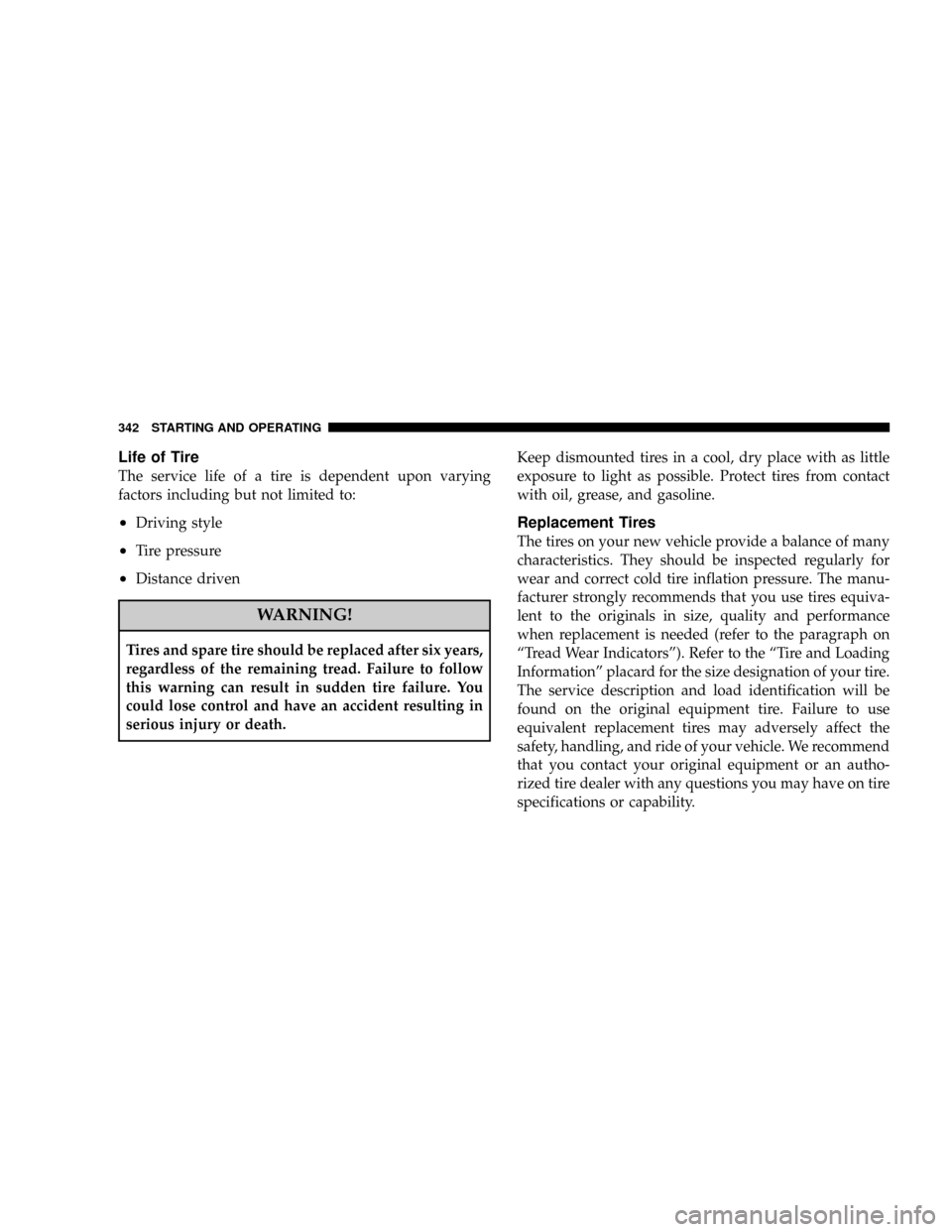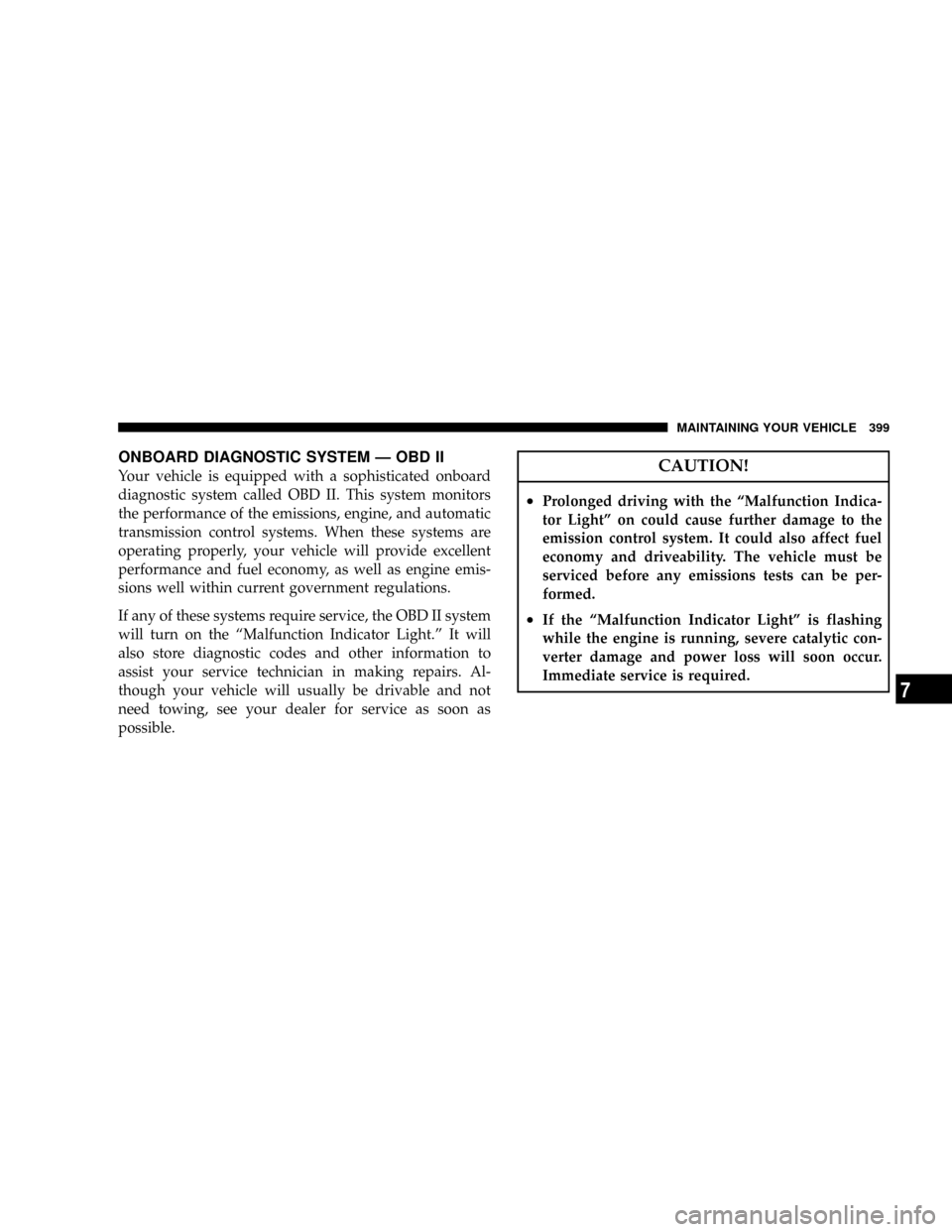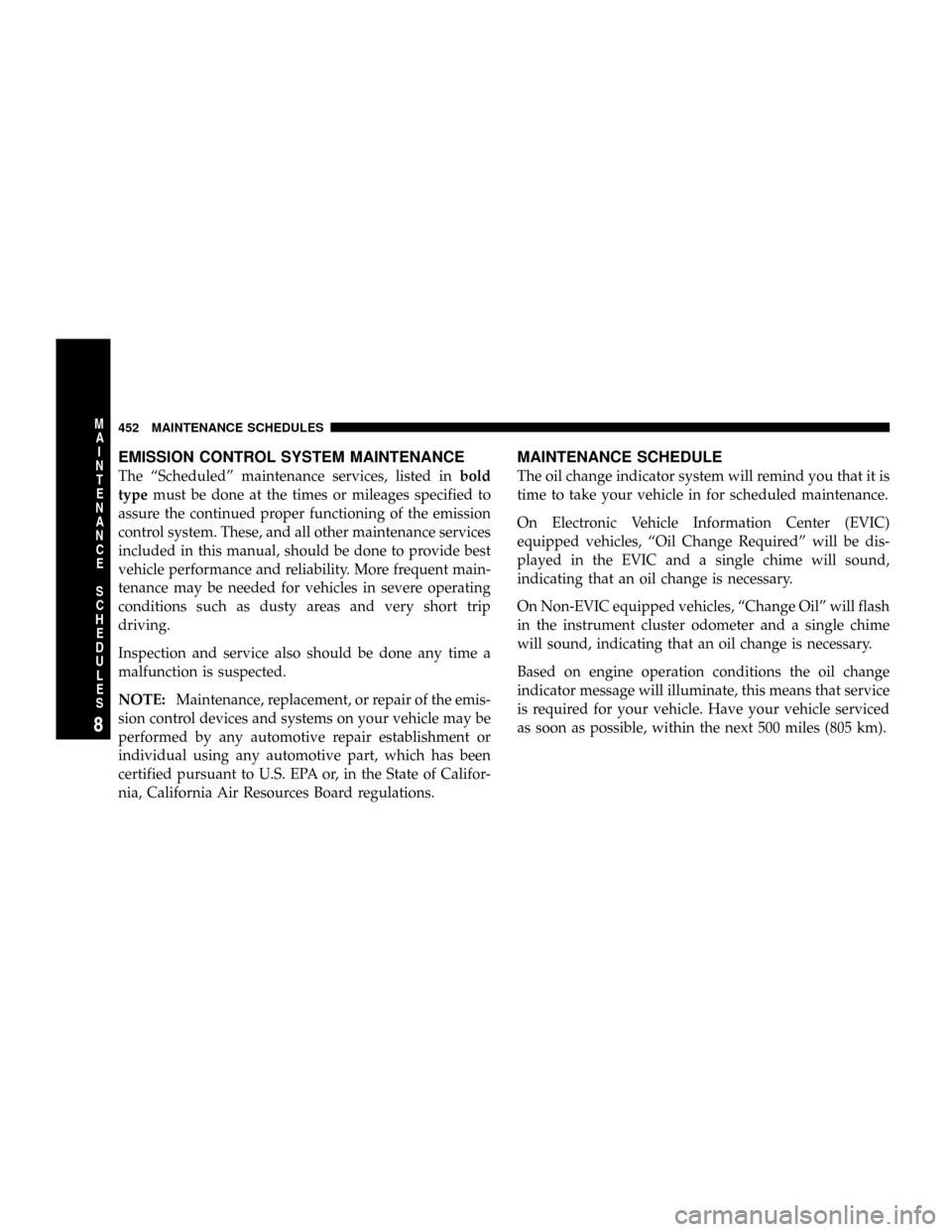service indicator JEEP LIBERTY 2008 KK / 2.G User Guide
[x] Cancel search | Manufacturer: JEEP, Model Year: 2008, Model line: LIBERTY, Model: JEEP LIBERTY 2008 KK / 2.GPages: 493
Page 209 of 493

²Door(s) Ajar (with a single chime if vehicle is in
motion)
²Liftgate Ajar (with a single chime)
²Left Front Low Pressure (with a single chime). Refer to
ªTire Pressure Monitoring Systemº in Section 5 of this
manual.
²Left Rear Low Pressure (with a single chime). Refer to
ªTire Pressure Monitoring Systemº in Section 5 of this
manual.
²Right Front Low Pressure (with a single chime). Refer
to ªTire Pressure Monitoring Systemº in Section 5 of
this manual.
²Right Rear Low Pressure (with a single chime). Refer
to ªTire Pressure Monitoring Systemº in Section 5 of
this manual.
²Check TPM System (with a single chime). Refer to
ªTire Pressure Monitoring Systemº in Section 5 of this
manual.
²Check Gascap (refer to ªAdding Fuelº in Section 5 of
this manual for more details)
²Service Park Assist System (with a single chime)
²Oil Change Required (with a single chime)
Oil Change Required
Your vehicle is equipped with an engine oil change
indicator system. The ªOil Change Requiredº message
will flash in the EVIC display for approximately 10
seconds after a single chime has sounded to indicate the
next scheduled oil change interval. The engine oil change
indicator system is duty cycle based, which means the
engine oil change interval may fluctuate dependent upon
your personal driving style.
INSTRUMENT PANEL AND CONTROLS 209
4
Page 270 of 493

²Most of the time, when in Automatic Operation, you
can temporarily put the system into Recirculation
Mode by pressing the Recirculation Button. However,
under certain conditions, while in Automatic Mode,
the system is blowing air out the defrost vents. When
these conditions are present, and the Recirculation
Button is pressed, the indicator will flash and then
turn off. This tells you that you are unable to go into
recirculation mode at this time. If you would like the
system to go into Recirculation Mode, you must first
move the Mode Knob to Panel, Panel/Floor and then
press the Recirculation Button. This feature reduces
the possibility of window fogging.
Operating Tips
NOTE:Refer to the chart at the end of this section for
suggested control settings for various weather condi-
tions.
Summer Operation
The engine cooling system in air-conditioned vehicles
must be protected with a high-quality antifreeze coolant
to provide proper corrosion protection and to protect
against engine overheating. A 50% solution of ethylene
glycol antifreeze coolant in water is recommended. Refer
to ªMaintenance Proceduresº in Section 7 of this manual
for proper coolant selection.
Winter Operation
Use of the air Recirculation mode during winter months
is not recommended because it may cause window
fogging.
Vacation Storage
Anytime you store your vehicle, or keep it out of service
(i.e. vacation) for two weeks or more, run the air condi-
tioning system at idle for about five minutes in the fresh
air and high blower settings. This will insure adequate
system lubrication to minimize the possibility of com-
pressor damage when the system is started again.
270 INSTRUMENT PANEL AND CONTROLS
Page 288 of 493

A Reset feature allows the vehicle to be driven to a dealer
for service without damaging the transmission. To reset
the transmission, perform the following procedure:
1. Stop the vehicle.
2. Move the selector lever to the ªPº (Park) position.
3. Turn off the engine; be sure to turn the key to the
LOCK position.
4. Wait approximately 10 seconds, and then restart the
engine.
5. Move the selector lever to the desired gear range.
If the problem is no longer detected, the transmission will
return to normal operation. If the problem persists, ªPº
(Park), ªRº (Reverse), and ªNº (Neutral) will continue to
operate. Only Second gear range will operate in the ªDº
(Drive) position. Have the transmission checked at your
authorized dealer as soon as possible.MANUAL TRANSMISSION Ð IF EQUIPPED
Clutch Interlocking Ignition System
Vehicles equipped with a manual transmission are
equipped with a clutch interlock safety feature. The
clutch pedal must be fully depressed to allow cranking of
the engine.
To enhance off-road performance, 4-wheel drive models
equipped with a manual transmission will start with or
without pressing the clutch pedal when in 4-wheel drive
low range. The 4 LOW indicator light will illuminate
when the transfer case is in 4-wheel drive low range.
288 STARTING AND OPERATING
Page 295 of 493

N
Neutral - Disengages both the front driveshaft and rear
driveshaft from the powertrain. To be used for flat
towing behind another vehicle. Refer to ªRecreational
Towingº in this section for more information.
Transfer Case Position Indicator Lights
The 4WD indicator lights are located in the instrument
cluster. The ªNº (Neutral) indicator light is located on the
4WD Control Switch. If there is no indicator light on or
flashing, the transfer case position is 2-wheel drive
(2WD). If the indicator light is on, the desired position
(4WD LOCK, 4WD LOW, or NEUTRAL) has been ob-
tained.
If One or More Shift Requirements are not met:
²An indicator light will flash.
²The transfer casewill notshift.NOTE:The ªSERV 4WDº warning light monitors the
electric shift 4WD system. If this light remains on after
engine start up, or it illuminates during driving, it means
that the 4WD system is not functioning properly and that
service is required.
Shifting Procedures
NOTE:If any of the requirements to select a new
transfer case position have not been met, the transfer case
will not shift, the indicator light for the previous position
will remain ON, and the newly selected position indica-
tor light will continue to flash until all the requirements
for the selected position have been met. To retry a shift,
move the 4WD Control Switch back to the original
position, make certain all shift requirements have been
met, wait five (5) seconds, and try the shift again.
STARTING AND OPERATING 295
5
Page 301 of 493

Interlocking Ignition Systemº under ªManual Transmis-
sionº or to ªStarting Proceduresº in this section for
details.
N
Neutral - Disengages both the front driveshaft and rear
driveshaft from the powertrain. To be used for flat
towing behind another vehicle. Refer to ªRecreational
Towingº in this section for more information.
Transfer Case Position Indicator Lights
The 4WD indicator lights are located in the instrument
cluster. The ªNº (Neutral) indicator light is located on the
4WD Control Switch. If there is no indicator light on or
flashing, the transfer case position is 2-wheel drive
(2WD). If the indicator light is on, the desired position
(4WD AUTO, 4WD LOW, or NEUTRAL) has been ob-
tained.If One or More Shift Requirements are not met:
²An indicator light will flash.
²The transfer casewill notshift.
NOTE:The ªSERV 4WDº warning light monitors the
electric shift 4WD system. If this light remains on after
engine start up, or it illuminates during driving, it means
that the 4WD system is not functioning properly and that
service is required.
Shifting Procedures
NOTE:If any of the requirements to select a new
transfer case position have not been met, the transfer case
will not shift, the indicator light for the previous position
will remain ON, and the newly selected position indica-
tor light will continue to flash until all the requirements
for the selected position have been met. To retry a shift,
move the 4WD Control Switch back to the original
STARTING AND OPERATING 301
5
Page 342 of 493

Life of Tire
The service life of a tire is dependent upon varying
factors including but not limited to:
²Driving style
²Tire pressure
²Distance driven
WARNING!
Tires and spare tire should be replaced after six years,
regardless of the remaining tread. Failure to follow
this warning can result in sudden tire failure. You
could lose control and have an accident resulting in
serious injury or death.Keep dismounted tires in a cool, dry place with as little
exposure to light as possible. Protect tires from contact
with oil, grease, and gasoline.
Replacement Tires
The tires on your new vehicle provide a balance of many
characteristics. They should be inspected regularly for
wear and correct cold tire inflation pressure. The manu-
facturer strongly recommends that you use tires equiva-
lent to the originals in size, quality and performance
when replacement is needed (refer to the paragraph on
ªTread Wear Indicatorsº). Refer to the ªTire and Loading
Informationº placard for the size designation of your tire.
The service description and load identification will be
found on the original equipment tire. Failure to use
equivalent replacement tires may adversely affect the
safety, handling, and ride of your vehicle. We recommend
that you contact your original equipment or an autho-
rized tire dealer with any questions you may have on tire
specifications or capability.
342 STARTING AND OPERATING
Page 399 of 493

ONBOARD DIAGNOSTIC SYSTEM Ð OBD II
Your vehicle is equipped with a sophisticated onboard
diagnostic system called OBD II. This system monitors
the performance of the emissions, engine, and automatic
transmission control systems. When these systems are
operating properly, your vehicle will provide excellent
performance and fuel economy, as well as engine emis-
sions well within current government regulations.
If any of these systems require service, the OBD II system
will turn on the ªMalfunction Indicator Light.º It will
also store diagnostic codes and other information to
assist your service technician in making repairs. Al-
though your vehicle will usually be drivable and not
need towing, see your dealer for service as soon as
possible.CAUTION!
²Prolonged driving with the ªMalfunction Indica-
tor Lightº on could cause further damage to the
emission control system. It could also affect fuel
economy and driveability. The vehicle must be
serviced before any emissions tests can be per-
formed.
²If the ªMalfunction Indicator Lightº is flashing
while the engine is running, severe catalytic con-
verter damage and power loss will soon occur.
Immediate service is required.
MAINTAINING YOUR VEHICLE 399
7
Page 400 of 493

Loose Fuel Filler Cap Message
If the vehicle diagnostic system determines that the fuel
filler cap in loose, improperly installed, or damaged, a
ªgASCAPº message will display in the instrument clus-
ter. Tighten the gas cap until a ªclickingº sound is heard.
This is an indication that the gas cap is properly tight-
ened. Press the trip odometer reset button to turn off the
message. If the problem persists, the message will appear
the next time the vehicle is started. This might indicate a
damaged cap. If the problem is detected twice in a row,
the system will turn on the Malfunction Indicator Light
(MIL). Resolving the problem will turn the MIL light off.
EMISSIONS INSPECTION AND MAINTENANCE
PROGRAMS
In some localities, it may be a legal requirement to pass
an inspection of your vehicle's emissions control system.
Failure to pass could prevent vehicle registration.For states, which have an I/M (Inspection and
Maintenance) requirement, this check verifies the
following: the MIL (Malfunction Indicator Light)
is functioning and is not on when the engine is running,
and that the OBD (On Board Diagnostic) system is ready
for testing.
Normally, the OBD system will be ready. The OBD
system maynotbe ready if your vehicle was recently
serviced, if you recently had a dead battery, or a battery
replacement. If the OBD system should be determined
not ready for the I/M test, your vehicle may fail the test.
Your vehicle has a simple ignition key actuated test,
which you can use prior to going to the test station. To
check if your vehicle's OBD system is ready, you must do
the following:
1. Insert your ignition key into the ignition switch.
400 MAINTAINING YOUR VEHICLE
Page 452 of 493

EMISSION CONTROL SYSTEM MAINTENANCE
The ªScheduledº maintenance services, listed inbold
typemust be done at the times or mileages specified to
assure the continued proper functioning of the emission
control system. These, and all other maintenance services
included in this manual, should be done to provide best
vehicle performance and reliability. More frequent main-
tenance may be needed for vehicles in severe operating
conditions such as dusty areas and very short trip
driving.
Inspection and service also should be done any time a
malfunction is suspected.
NOTE:Maintenance, replacement, or repair of the emis-
sion control devices and systems on your vehicle may be
performed by any automotive repair establishment or
individual using any automotive part, which has been
certified pursuant to U.S. EPA or, in the State of Califor-
nia, California Air Resources Board regulations.
MAINTENANCE SCHEDULE
The oil change indicator system will remind you that it is
time to take your vehicle in for scheduled maintenance.
On Electronic Vehicle Information Center (EVIC)
equipped vehicles, ªOil Change Requiredº will be dis-
played in the EVIC and a single chime will sound,
indicating that an oil change is necessary.
On Non-EVIC equipped vehicles, ªChange Oilº will flash
in the instrument cluster odometer and a single chime
will sound, indicating that an oil change is necessary.
Based on engine operation conditions the oil change
indicator message will illuminate, this means that service
is required for your vehicle. Have your vehicle serviced
as soon as possible, within the next 500 miles (805 km).
452 MAINTENANCE SCHEDULES
8
M
A
I
N
T
E
N
A
N
C
E
S
C
H
E
D
U
L
E
S
Page 473 of 493

Chart, Tire Sizing........................ 330
Check Engine Light (Malfunction Indicator
Light)................................ 400
Checking Your Vehicle For Safety............. 79
Checks, Safety........................... 79
Child Restraint....................69,70,74,76
Child Restraint Tether Anchors.............73,74
Child Safety Locks........................ 33
Clean Air Gasoline....................... 356
Cleaning
Windshield Wiper Blades................. 413
Climate Control......................... 260
Clock...........................224,239,243
Clutch Fluid Reservoir.................... 424
Clutch Interlocking Ignition System........... 288
Coin Holder........................... 173
Cold Weather Operation................... 278
Command-Trac Operation.................. 292
Compact Disc (CD) Maintenance............. 259Compass.............................. 212
Compass Calibration..................204,212
Compass Variance....................204,213
Computer, Trip/Travel.................... 210
Console.............................. 173
Console, Floor.......................... 173
Contract, Service........................ 462
Converter, Catalytic...................... 407
Coolant Pressure Cap (Radiator Cap).......... 418
Cooling System......................... 416
Adding Coolant (Antifreeze).............. 418
Coolant Capacity...................... 447
Coolant Level......................416,419
Disposal of Used Coolant................ 419
Drain, Flush, and Refill.................. 417
Inspection........................... 419
Points to Remember.................... 420
Pressure Cap......................... 418
Selection of Coolant (Antifreeze)......417,447,448
INDEX 473
10